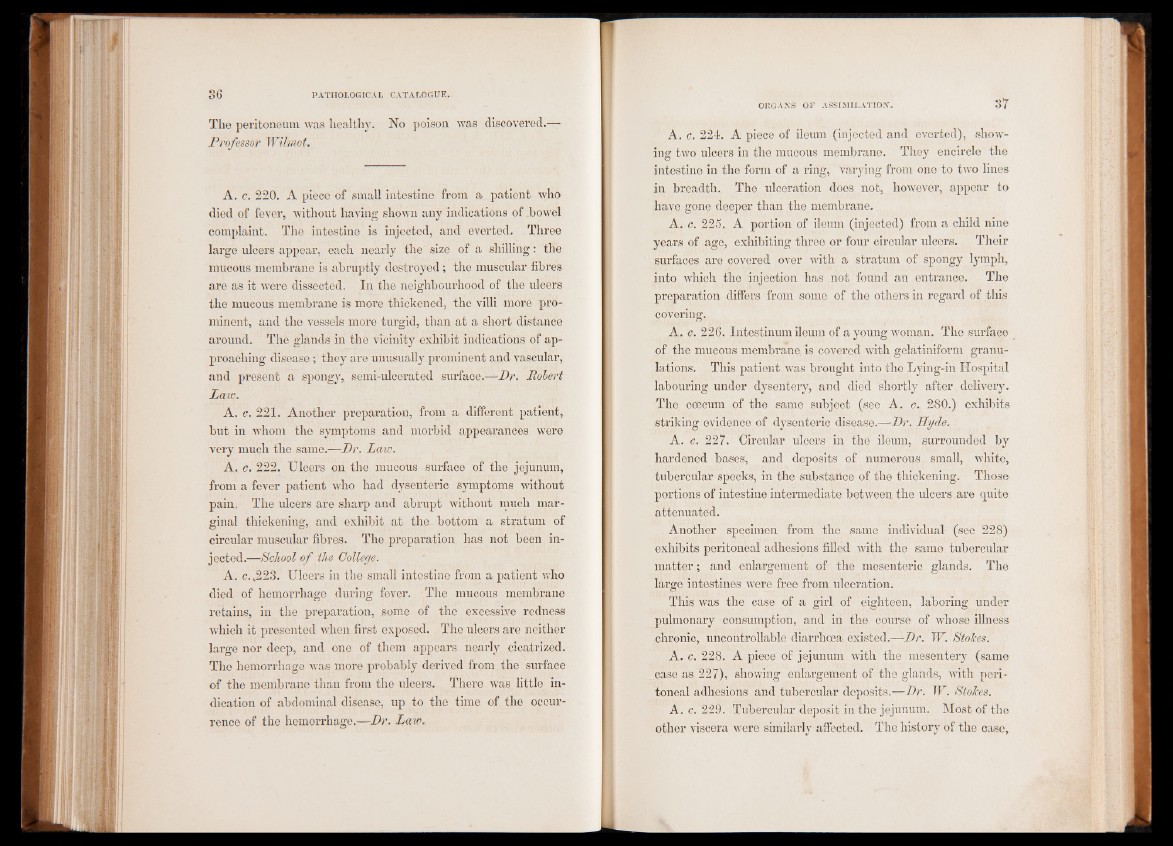
PATHOLOGICAL 36 CATALOGUE.
The peritoneum was healthy. No poison was discovered.—
Professor Wilmot.
A. c. 220. A piece of small intestine from a patient who
died of fever, without having shown any indications of bowel
complaint. The intestine is injected, and everted. Three
large ulcers appear, each nearly the size of a shilling: the
mucous membrane is abruptly destroyed; the muscular fibres
are as it were dissected. In the neighbourhood of the ulcers
the mucous membrane is more thickened, the villi more prominent,
and the vessels more turgid, than at a short distance
around. The glands in the vicinity exhibit indications of approaching
disease ; they are unusually prominent and vascular,
and present a spongy, semi-ulcerated surface.—Dr. Robert
Law.
A. c. 221. Another preparation, from a different patient,
but in whom the symptoms and morbid appeai’ances were
very much the same.—Dr. Law.
A. c. 222. Ulcers on the mucous surface of the jejunum,
from a fever patient who had dysenteric symptoms without
pain. The ulcers are sharp and abrupt without much marginal
thickening, and exhibit at the bottom a stratum of
circular muscular fibres. The preparation has not been injected.—
School of the College.
A. c.,223. Ulcers in the small intestine from a patient who
died of hemorrhage during fever. The mucous membrane
retains, in the preparation, some of the excessive redness
which it presented when first exposed. The ulcers are neither
large nor deep, and one of them appears nearly cicatrized.
The hemorrhage was more probably derived from the surface
of the membrane than from the ulcers. There was, little indication
of abdominal disease, up to the time of the occurrence
of the hemorrhage.—Dr. Law.
A. c. 224. A piece of ileum (injected and everted), showing
two ulcers in the mucous membrane. They encircle the
intestine in the form of a ring, varying from one to two lines
in breadth. The ulceration does not, however, appear to
have gone deeper than the membrane..
A. c. 225. A portion of ileum (injected) from a child nine
years of age, exhibiting three or four circular ulcers. Their
surfaces are covered over with a stratum of spongy lymph,
into which the injection has not found an entrance. The
preparation differs from some of the others in regard of this
covering.
A. c. 226. Intestinum ileum of a young woman. The surface
of the mucous membrane is covered with gelatiniform granulations.
This patient was brought into the Lying-in Hospital
labouring under dysentery, and died shortly after delivery.
The ccecum of the same subject (see A. c. 280.) exhibits
striking evidence of dysenteric disease.—Dr. Hyde.
A. c. 227. Circular ulcers in the ileum, surrounded by
hardened bases, and deposits of numerous small, white,
tubercular specks, in the substance of the thickening. Those
portions of intestine intermediate between the ulcers are quite
attenuated.
Another specimen from the same individual (see 228)
exhibits peritoneal adhesions filled with the same tubercular
matter; and enlargement of the mesenteric glands. The
large intestines were free from ulceration.
This was the case of a girl of eighteen, laboring under
pulmonary consumption, and in the course of W'hose illness
chronic, uncontrollable diarrhoea existed.—Dr. W. Stokes.
A. c. 228. A piece of jejunum with the mesentery (same
case as 227), showing enlargement of the glands, with peritoneal
adhesions and tubercular deposits.—Dr. W. Stokes.
A. c. 229. Tubercular deposit in the jejunum. Most of the
other viscera were similarly affected. The history of the case,